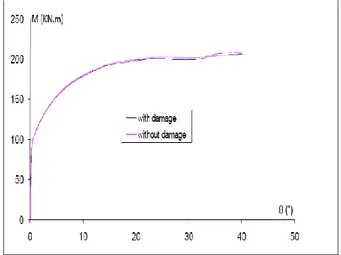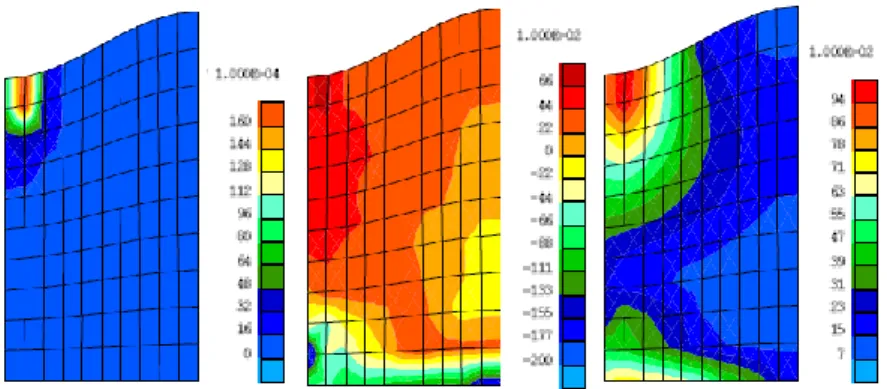X International Conference on Computational Plasticity COMPLAS X E. Oñate and D. R. J. Owen (Eds) CIMNE, Barcelona, 2009
THE ROLE OF VOID EVOLUTION ON THE BENDABILITY OF
STEEL SHEETS
M. Ben Bettaieb*, X. Lemoine† , L. Duchêne*and AM. Habraken* *
Department ArGEnCo, Division MS2F, University of Liège, Chemin des Chevreuils 1, 4000 Liège, Belgium
e-mail: Mohamed.BenBettaieb@ulg.ac.be, web page: http://www.argenco.ulg.ac.be
† Arcelor-Mittal Research S.A., voie romaine, F-57238
Maizière-les-Metz, France
Key words: Bendability, Gurson model, steel sheet, finite element method
Summary. In the present contribution, an advanced Gurson model is developed and
implemented in the Lagamine finite element code[1. This model is used to simulate the bending process and to predict the bendability of the studied sheet.
1 INTRODUCTION
The theoretical prediction of the bendability of metallic sheets is an ambitious goal to be reached. In this aim, many numerical models and methods, essentially based on the finite element analysis, are developed and applied to simulate the bending. In order to predict the bendability, the finite element method is generally coupled with some damage laws (Gurson model, Lemaitre model ...).
The present contribution lies within the scope of this strategy and consists in using a new advanced Gurson model to study the bending process and to predict the bendability of steel sheets. The studied medium is assumed to be decomposed into two principal phases: a fully dense matrix and spherical voids. The behavior of the dense matrix is defined by the anisotropic Hill 48 yield function coupled with a mixed (kinematic and isotropic) hardening model. The spherical voids remain spherical during the loading. The nucleation and the growth phases are modeled on the basis of the work of Bouaziz et al.[2.
The proposed constitutive law is integrated by using an explicit-implicit algorithm and implemented into Lagamine finite element code[1. The numerical tool is used to simulate the bending process for monotonic loading.
2 THEORETICAL FORMULATION
The set of constitutive equations of this advanced Gurson model is defined by four principal relations. The first relation is the yield function:
2 2 2 1 3 2 2 cosh 1 0 eqa m p Y Y q F q f q f (1)
M. Ben Bettaieb, X. Lemoine, L. Duchêneand A-M. Habraken
2
This yield function is very similar to the initial Gurson yield function but with some modifications. Indeed the kinematic hardening, the isotropic hardening and the plastic anisotropy are considered. For more details about the definition of the different components of the last equation, see[3.
The second relation within the constitutive equations is the plastic flow rule defined by the normality relation:
; 0
p
p F
(2) The third relation is the equivalence between the rates of macroscopic plastic work and matrix plastic work:
: p (1 f) Y mp (3)
The fourth relation is the modeling of the porosity f . This modeling is based on the 3D microtomography experimental technique. Bouaziz et al.[2 demonstrated that the numerical density of voids N increases exponentially as a function of the equivalent plastic strain and the triaxiality factor. However the mean radius of cavities R is modeled by the classic Rice and Tracey model modified by the nucleation effects. The exact expressions of the nucleation and growth kinetics are extensively studied[2,[3. Then the porosity evolution can be written in the following form:
3 ; (4 / 3) 1 NV f V R NV (4)
This evolution law is connected to the developed Gurson model by using the yield function (1), the normality law (2) and the plastic incompressibility of the matrix. The combination of these three ingredients leads to the derivation of an analytical relation between the parameter
2
q of the yield function (1), the triaxiality factor and the plastic strain p.
2 NUMERICAL IMPLEMENTATION
The previous constitutive equations are implemented into Lagamine finite element code by using an explicit-implicit algorithm. This algorithm is explicit with respect to the porosity f
and implicit with respect to the other variables. This choice was imposed by the complexity of the coupling dependence of f to the different variables. The implicit part is based on the classic Aravas’s algorithm[
4 after some improvements and extensions (to the case of the plastic anisotropy and kinematic hardening). For more details about this algorithm, see[5. The tangent matrix is computed by using the perturbation technique. It must be noted that this technique does not induce a significant increasing in the computation cost.
M. Ben Bettaieb, X. Lemoine, L. Duchêneand A-M. Habraken
3
4 NUMERICAL RESULTS 4.1 Material data
The material used here is the DP 600 steel. The mechanical properties of the dense matrix are given by Arcelor-Mittal. However the parameters of the damage laws are given in[2. An initial porosity of 0.001 is assumed in the modeling. This value is usually taken for metallic materials and allows taking into account the initial imperfection of the material. The same set of material parameters was used in[3.
4.2 Geometry and boundary conditions
In this article, an initially parallelepiped block of porous material is given a sinusoidal geometric imperfection at the upper surface. This technique was initially introduced by Tvergaard[7 in order to promote the damage development. The studied specimen is submitted to a pure bending test by applying a couple of forces.
4.3 Numerical results
The evolution of the bending moment M versus the bending angle is plotted in Figure 1. This figure displays the role of the damage on the bendability. The application of the advanced Gurson model leads to a weak decrease of the predicted M- curve because of the damage evolution.
Figure 1 : Effect of the void development on the M- curve
Figure 2 shows a very heterogeneous spatial distribution of the plastic strain, of the triaxiality factor and as a consequence of the damage in the bended specimen. The damage is maximum in the geometric imperfection. This result is in a good agreement with the results displayed[8.
M. Ben Bettaieb, X. Lemoine, L. Duchêneand A-M. Habraken
4
Figure 2 : Isovalues of: (a) plastic strain, (b) triaxiality, (c) damage 5 CONCLUSIONS
A new Gurson model was developed. This model is used to simulate the pure bending process and to evaluate the bendability. The role of the void development on the bendability is displayed. The proposed model will be connected to the Thomason coalescence criterion[6 in order to further understand the effect of voids on the bendability. The cooperative role of the damage development and of the Bauschinger effect will also be studied by applying cyclic bending loading.
ACKNOWLEDGMENTS
The authors acknowledge Arcelor-Mittal Research S.A. and the Interuniversity Attraction Poles Program - Belgian State – Belgian Science Policy (P6-24). A.M. Habraken and L. Duchêne also acknowledge the Belgian Fund for Scientific Research FRS-FNRS for its support.
REFERENCES
[1] Zhu Y.Y., Cescotto S., Habraken A.M, A Fully Coupled Elastoplastic Damage Modeling and Fracture Criteria in Metal Forming Processes. Journal of Materials Processing Technology. Vol. 32, pp. 197-204, 1992.
[2] Bouaziz O., Maire E., Giton M., Lamarre J., Salingue Y., Dimichiele M.: A model for initiation and growth of damage in dual-phase steels identified by X-ray micro-tomography. La revue de métallurgie, 2:102-107, 2008.
[3] Ben Bettaieb M., Lemoine X., Bouaziz O., Habraken AM.: Damage initiation and growth in DP steel sheets, submitted to Acta Materialia
[4] Aravas N.: On the Numerical Integration of a Class of Pressure-Dependent Plasticity Models. International Journal of Numerical Methods and Engineering, 24:1395-1416, 1987
[5] Ben Bettaieb M., Lemoine X., Duchêne L., Habraken A-M: On the numerical integration of an advanced Gurson model, submitted to publication in International Journal for Numerical Methods in Engineering [6] Thomason P.F., “Ductile fracture of metals”. Oxford: Pergamon Press, 1990.
[7] Tvergaard V., “Effect of yield surface curvature and void nucleation on plastic flow localization”. Journal of the mechanics and physics of solids, 35:43-60, 1987
[8] Lievers W.B., Pilkey A.K., Worswick M.J., “The co-operative role of voids and shear bands in strain localization during bending”. Mechanics of Materials, Volume 35, Issue 7, July 2003, Pages 661-674

